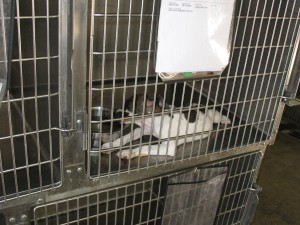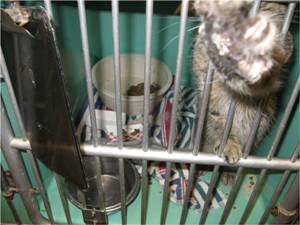Please note: This post has disturbing images of animal neglect and abuse in U.S. shelters.
When PETA employees like Teresa Chagrin and Daphna Nachminovitch turn off their computers after a long day of work, do they sit back with a contented smile and think, “I had a great day, I caused a lot of animals to die today”? Since they were hired to protect PETA’s ability to round up and kill 97% of animals they seek out, including “healthy,” “adoptable,” “perfect” and “adorable” ones—all descriptions used by PETA employees to describe animals they have slaughtered, is a “good day at the office” a lot of killing?
I do not know if they kill the animals themselves, but they certainly encourage it, defend it, promote it and work to ensure that “shelters” across the country keep doing it, too. And judging by how many letters to the editor they write on that score and how PETA appears to be increasing its anti-No Kill rhetoric, it is job they do with relish. Why? Because they are part of the PETA death cult, people who do what their charismatic leader, Ingrid Newkirk, tells them to do: defend, legitimize and promote the killing of companion animals, even if that means “lying.”
I put “lying” in quotes because it is not clear whether they know they are not telling the truth. If they aspired to be rational, sincere, dedicated to animal rights and true animal lovers, they would be lying. But they are none of those things. And because PETA appears to be a cult and by a cult’s very nature, any information from outside the cult is considered evil, especially if it is opposing the cult, and because cults train their members to instantly destroy any critical information given to them and not even entertain the thought that the information could be true, it is not clear whether Nachminovitch or Chagrin are even capable of the logical analysis necessary to determine if anything related to No Kill or PETA’s annual slaughter of animals is true or not true.
They ignore the fact that dozens of No Kill communities representing hundreds of towns and cities across America now exist in order to argue that “open admission” shelters cannot be No Kill. They ignore the fact that pet overpopulation is a myth because the number of people who bring a new animal into their home (demand), far exceeds supply in order to argue that there aren’t enough homes for animals. And they ignore the fact that No Kill has nothing to do with hoarding in order to claim that they do.
It is therefore no surprise that despite the facts and evidence to the contrary, once again, the people that have put to death over 27,000 animals in the last ten years, who have argued for a Pit Bull ban in all shelters and thus a mass slaughter, who champion the round up and killing of free-living cats, and who oppose rescue access laws would release yet another article equating No Kill with hoarding and arguing that giving animals a quick death should always be the norm. In this recent attack, they write that No Kill shelters “warehouse animals, often in substandard, filthy, and severely crowded conditions, for weeks, months, or even years on end;” that “no homes exist” for animals; and that the lucky animals are the ones who are killed at traditional shelters—all assertions that are not only untrue, but easily refuted by the many successful No Kill communities across the nation. And so it should also surprise no one that despite listing 43 “examples” of “No Kill shelters” and “No Kill rescue groups” where animals were allegedly kept in substandard conditions in order to prove their claims, these examples not only prove the opposite, they show that PETA is willing to simply make up stories to defend their killing.
What is a “PETA Fact”?
Every family has its lexicon, inside phrases which would not make sense to anyone outside the family but which convey instant meaning to those in the know. Our family is no exception. Whenever we hear a news story with widely exaggerated statistics (“Every three seconds, someone in the U.S:”), one of us will invariably say, “That’s a PETA fact.” A “PETA fact” is a non-fact, something totally made up. And we call it a “PETA fact” because the king of PETA facts is PETA itself. A look at their latest attack against No Kill proves it.
In their most recent No Kill hit piece, PETA offers 43 examples to prove No Kill equals hoarding. Of those, I have personal knowledge of three. And all three are inaccurate. In other words, they are “PETA facts.” The first example they cite for the proposition that No Kill leads to hoarding is Austin, Texas. They state that “after the city of Austin opened a new $12 million facility and proclaimed it to be ‘no-kill,’ animal drop-offs skyrocketed and desperate officials asked members of the public what they were supposed to do. The ‘no-kill’ policy is increasing the need to euthanize animals.” Austin, like every community—No Kill or not—has had its challenges. But this claim is far from true, especially the claim that, “The ‘no-kill’ policy is increasing the need to euthanize animals.”
In fact, not only is that inherently contradictory, it is not even remotely true. In 2011, the City of Austin finished the year with a 91% rate of lifesaving and they are on pace to do the same in 2012. From the roughly 45% kill rate it once had to the 91% save rate that the city now has, how is No Kill leading to more killing? PETA has simply made it up. Moreover, since PETA supports shelter killing, kills animals themselves and wants shelters to kill even more, even if it were true, why would they complain? If Austin’s No Kill policy increases “the need to euthanize animals,” they should be applauding.
The second example they use as proof that No Kill leads to warehousing involves Porter County, Indiana. They write that an architect hired by the County once wrote that the shelter “should cease trying to call itself a no-kill shelter until it can reduce the number of animals’ it takes in.” According to PETA, “The report says to do otherwise would result in severely crowded, unsanitary conditions, which could lead to illness, cruelty, and death.” That’s “would result in” not did result in. What the architect said was that he believes No Kill leads to warehousing, not that it was occurring in the shelter. And he said it because he is a former HSUS employee of 11 years, working there at the height of their anti-No Kill opposition and vitriol. In other words, his history would indicate an anti-No Kill bias, which he is simply parroting in his report. It was merely a statement of opinion about No Kill in general, not about conditions he saw in Indiana. So what does this prove? It proves only this: someone once made a statement against No Kill in a report somewhere in Indiana. It is apropos of nothing.
The third example they use is that “Indianapolis Animal Care and Control Director Doug Rae was fired from his position after just 10 months on the job. Reasons for his dismissal included putting too much emphasis on adoptions and not enough attention on stray animals and leaving more than 2,000 animals on the streets.” They then claimed I supported Rae. I did. And I still do. First, there is nothing wrong with putting emphasis on adoptions. Ultimately, that is a shelter’s most important job. Second, Rae did not ignore strays, nor was he removed for that reason. Rae was removed from his position because the powerful union—threatened by his insistence on staff accountability for their job performance and their continued employment—pushed for his removal and the Mayor cut a deal with the union for political support.
During Rae’s tenure, he improved response times for stray animals by holding the underperforming union-protected staff accountable. Before he was hired, staff simply did not respond to calls for field services. He also radically improved animal care and lifesaving at an agency with a history not only of mass killing, but horrific neglect and abuse—animals with rotting, open sores covered with maggots and others being dragged to their deaths and then killed in an abusive way, with blood splattered all over the kill room. And when Rae began reforming the shelter, firing abusive staff, cleaning up operations, he not only had his car vandalized by union-protected thugs, they threatened him with physical violence. (The employee who did so has since been rehired). And the person who led the charge to fire Doug and who headed the union that represented shelter employees was a convicted felon who spent time in prison for armed robbery. As it turns out, the strong-armed robbery was not the only time the union thug and shelter employee had been in trouble with the law. One year prior to his robbery, he and his brother were indicted for murder. The two men were accused of shooting and killing a man while he sat in his car in a liquor store parking lot.
This is the person whom PETA is siding with in their false attacks against Rae, a man who worked diligently and with great dedication to reform a cruel and abusive shelter and who did so at great personal risk to his safety. In fact, under Rae’s tenure, Indianapolis had the single best adoption day in state history—he kept the shelter open until 10 pm, vowing not to close as long as people were there to adopt—saving 153 animals in one day, animals who would have been killed in years past and are being killed now because Rae was driven out, while PETA applauds, taking the side of criminals, thugs, pet killers and abusers who once cornered Rae in the shelter bathroom and threatened: “You better watch your back,” employees who dumped dog food on his car and then smashed his windshield.
Of the three examples I am aware of, all three turn out to be nothing more than “PETA facts.” That is a 100% rate of inaccuracy. How many of the others with which I am not intimately familiar are also lies? Even if we assume for the sake of argument that the remaining “examples” are all accurate, admittedly a dubious proposition, PETA has 40 examples spanning four years and two countries. In other words, 40 shelters and rescue groups which called themselves “No Kill” had problems. That is, 40 groups which claimed to be No Kill but which did not faithfully represent what No Kill is really all about. What exactly does that prove? Highlighting false examples of No Kill while entirely ignoring the tens of thousands of rescue groups and now dozens of No Kill communities which do authentically represent the No Kill philosophy doesn’t prove anything beyond the fact that people who are not really interested in the welfare and rights of animals can claim to be people who are—just like PETA does.
And what of the “open admission” kill shelters they continually applaud and misportray? While they highlight false examples of No Kill and ignore the real ones, they also ignore the rampant abuse at traditional shelters and falsely represent them as dedicated to the best interests of animals. In my upcoming book, Friendly Fire, I look at conditions in U.S. kill shelters. To put it mildly, the numbers and conditions trump PETA’s, like this anti-No Kill “open admission” shelter:
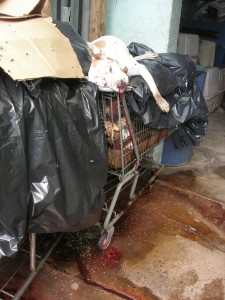
(those are maggots all over the dog and floor)
Or this one:
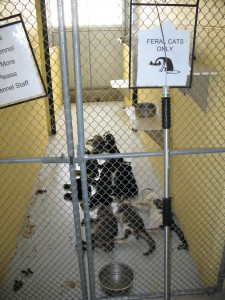
Or this one:
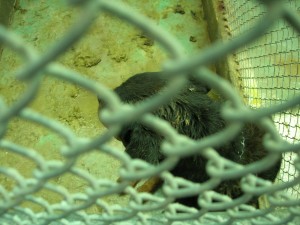
Or this one:
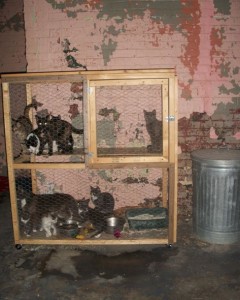
Or this one:

Or this one:
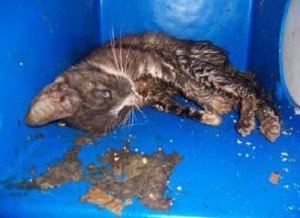
Given that there are, in all likelihood, tens of thousands of No Kill rescue groups across the U.S. and PETA, at best, has a few dozen examples of problems, how does that prove that No Kill leads to warehousing as a matter of policy? If it shows anything, it only shows how rare hoarding is which should not surprise anyone because hoarding is rare. Animal hoarding is the result of mental illness and is not as common as many animal protection organizations would have us believe. Psychologists estimate that only 2% of the population suffers from hoarding, and of those, not all of them “collect” animals—many collect inanimate objects. By contrast, killing is endemic to animal shelters in the U.S. In fact, killing is the number one cause of death for healthy dogs and cats in the United States. At your “average” shelter, an animal has a 50% chance of being killed, compared to the rare chance of ending up with a hoarder. Of course, in places like Memphis, Tennessee, the odds are more extreme: as high as 80% are killed. And when it comes to animals which are sent to rescue, they all have a 100% guarantee of being killed because rescue groups are only empowered to save those animals scheduled to be killed. So, there is a 100% chance the animal is killed vs. a slim to none possibility, they’ll end up with a hoarder. Isn’t the conclusion obvious? But not to PETA.
PETA Defends Neglect & Abuse
PETA betrays animals not only by killing them, not only by encouraging shelters to kill more of them, and not only by condemning and misrepresenting those who want to save their lives, but by defending those who abuse and kill them, too. Their real concern is not the animals (if it was, they wouldn’t be killing 97% of them). Moreover, they ignore neglect and abuse when it happens in killing shelters.
Imagine a place where animals do not get fed. Imagine a place where animals with painful injuries do not get the veterinary care they need. Imagine a place where animals are stuck in cages and forced to wallow in their own waste. Imagine a place where the animals’ food is dirtied by cat litter and even fecal material. Imagine a place filled with dead and dying animals simply discarded in the garbage. These behaviors are the textbook definition of hoarding, but they also adequately describe conditions animals across this nation must endure when they enter their local “shelter.” And yet as long as there is intentional killing to accompany the abuse and neglect, PETA will defend those agencies.
In 2009, I was hired by the City of Houston Health Department to evaluate the shelter. The shelter allowed animals to go long periods without food or water, allowed animals to suffer, allowed filthy conditions and abuse. PETA defended the agency, telling city officials not to listen to me. In 2008, I did a similarly assessment in King County WA on behalf of the County Commission. Conditions there including animals left to die with no care of any kind, animals with no food or water over a period of days, and more. When the shelter claimed I was lying, they hired U.C. Davis to do its own assessment. U.C. Davis reaffirmed my findings. Yet, there too, PETA defended that agency, calling me and others who suggested reform “radical” and encouraging legislators not to listen. To PETA, as long as there is “intentional killing,” nothing else matters, including neglect and abuse of animals.*
So when animals are kept like this kitten who was forgotten and left to starve:
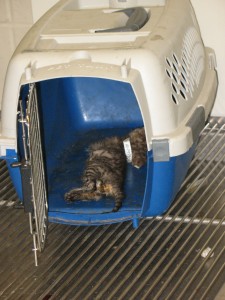
Or like this dying puppy left in a cold, barren cage, with no blanket so he is covered in his own urine:
Or like this cat who, along with others, was not fed for several days in the shelter and is begging for food and water:
Or when, as occurred, puppies are drowned, animals are abused, and shirkers are protected, as was true then in King County and Houston several years ago, PETA defends those shelters precisely because they also kill the animals. By contrast, I have never and would never defend abuse and neglect just because a “rescue” group calls itself “No Kill.” Hoarding is not what the No Kill movement represents. In fact, No Kill is the opposite of hoarding, filth, and lack of veterinary care. The philosophical underpinning of the No Kill movement is to put actions behind the words of every shelter’s mission statement: “All life is precious.” No Kill is about valuing animals, which not only means saving their lives, but means good quality care. It means vaccination on intake, nutritious food, daily socialization and exercise, fresh and clean water, medical care, and a system built to find them all loving, new homes as soon as possible.
At the open admission No Kill shelter I ran in Tompkins County (NY), the average length of stay for animals was eight days, we had a return rate of approximately 2%, we reduced the disease rate by nearly 90% from the prior administration, we reduced the intentional killing rate by 75%, no animal ever celebrated an anniversary in the facility, and we saved 93% of all impounded animals. And while there, animals were vaccinated on intake, received a thorough health examination, were given comprehensive medical treatment at the Small Animal Hospital run by the top veterinary college in the nation (Cornell), fed nutritious food and fresh water daily, kept clean, and were regularly exercised and socialized. Dogs were required to get out of their kennel a minimum of four times a day and cats were required to get out of theirs at least two times a day. In short, we brought sheltering into the 21st century, something that is deeply threatening to Newkirk and why her organization continually fights No Kill. Why?
The more shelters that are brought into the 21st century, the more Newkirk loses the ability to cloak PETA’s own killing in a 19th century model of catch and kill sheltering. By contrast, a nation where No Kill animal shelters are the norm, where animals at every shelter are given both good quality care and the loving, new homes they deserve will further reveal how senseless and cruel PETA’s own killing is. Newkirk will no longer find safety in numbers and she, and the mindless, heartless drones she has recruited to her insidious cause, won’t let that happen without a fight.
———————-
* They did not listen to PETA. On June 11, I asked shelters across the country not to kill and to focus on adoptions as part of a national day of No Kill. Houston’s animal control shelter was one of 800 organizations that answered the call. Normally closed on Monday, they stayed open and saved over 200 animals. They are also sending five employees to the No Kill Conference. And King County’s save rate has been improving.
PETA: if you want to send another letter threatening me with legal action, save yourself the postage and send it here.
Everyone else: if you want to comment on this blog, join the discussion at facebook.com/nathanwinograd.
